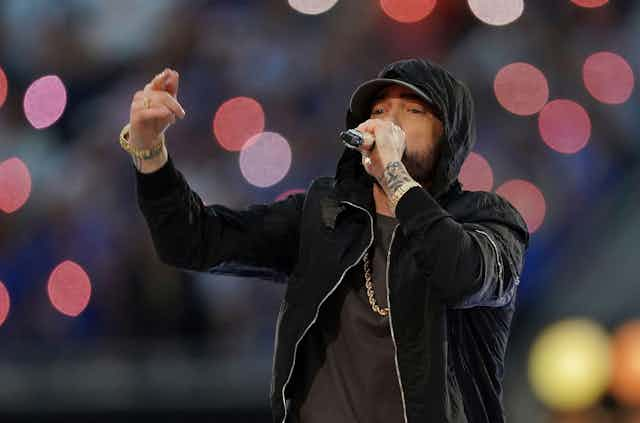Eminem burst onto the music scene in 1999 with The Slim Shady LP. The album’s lead single, My Name Is, introduced himself to the world along with his alter ego Slim Shady, a lovable (or detestable, depending on your perspective) bad boy and outrageous white emcee unafraid of self-ridicule. He declared that he had been sent by god to “piss the world off”.
Just over a year later came a new album The Marshall Mathers LP. The lead single, The Real Slim Shady, worked almost as a manifesto to inform listeners what Slim Shady had done (made the critics unable to stomach him), what he’s doing now (rapping about things others don’t dare to), and what he’s going to do (carry on exactly as he is).
Since then, Eminem has routinely used the lead singles from his studio albums to reintroduce himself. His latest, Houdini, is no different. It provides updates on his life, rallies against those wishing to censor him and ruminates on how the world of hip-hop has been faring in his absence. And, of course, he always leaves time to ridicule numerous of-the-moment celebrities along the way.
In 2002’s Without Me, for example, Eminem embraced his status as an anti-hero. Despite the best efforts of MTV and the Federal Communications Commission to “shut him down”, he tells us he remains a “rebel” who refuses to be silenced. He describes himself as “obscene”, a “monster” and a “nuisance” – but also a “visionary” and the “centre of attention”, who can’t be ignored.
In Without Me, Eminem also comments on his place within the hip-hop genre, expounding on his self-proclaimed importance to the industry and the rap game. But he also shows an understanding of the history of whiteness in hip-hop and the longstanding racial advantage that has historically seen white artists profit from forms of music created by black artists.
As with the name-checking of Pamela Anderson in My Name Is and rapper Fred Durst in The Real Slim Shady, in Without Me, Eminem again uses celebrity references (Limp Bizkit, Lynne Cheney) to tie the song to a particular time. This is something he seeks to do so listeners can look back at songs and remember what was going on at that moment.
Widely considered a failure by critics, Eminem has described his 2004 album Encore as “mediocre”. The lead single, Just Lose it, spends much of its time looking backward, revisiting the “guess who’s back” refrain from Without Me, and parodying one of Eminem’s rap battle scenes from his 2002 film 8 Mile.
In Just Lose It, Eminem’s celebrity bashing is narrower than the previous releases, focusing exclusively on Michael Jackson. But the child abuse allegations he refers to still place the song in a specific period – as does the appearances of socialite Paris Hilton in the music video.
Just Lose It shows Eminem struggling with his mental health issues and lacking lyrical inspiration. The line “what else could I possibly do to make noise, having touched on everything but little boys” certainly suggests he’s exhausted his subject matter (as well as delivering yet another jibe at Jackson).
As a 2004 review noted: “Just Lose It is as definitively about having nothing to say as Stan was about having said too much.” Despite this, Eminem does enough to remain an anti-hero – the man who dares to say what nobody else will, even if the controversy in this case is buried among nonsensical lyrics, instead of front and centre.
Five years, a greatest hits album and a drug overdose separate Encore from Relapse (2009). But the lead single We Made You made it feel like five minutes.
Eminem begins the song by asking whether we missed him and reassuring us that he was once again “back” (this time by “popular demand”), before launching into the song’s main focus: celebrity ridicule.
Merciless in its lampooning of celebrity culture, We Made You may be the best example of Eminem capturing the moment. References to Kevin Federline, Sarah Palin, Samantha Ronson and Amy Winehouse combine to provide the most immovable timestamp yet.
His suggestion that he would “nail” Palin (then governor of Alaska) and casting porn actress Lisa Ann to play her in the music video underlines his lack of respect for authority, a key characteristic of an antihero. But it’s also a reminder of the sexism that underscores much of the dark humour in Eminem’s music.
With the sample from Without Me, and the media controversy surrounding its lyrics, Houdini could persuade us it was 2002 all over again.
Elsewhere in the song, Eminem reinforces the notion that little has changed in the intervening years, declaring that he is “still a white jerk” who says what he thinks and isn’t going to change, even if it means getting “cancelled”.
He describes himself as a “prick”, “dope fiend” and “devil”, but also as a lyrical technician. This mirrors the lyrics of Without Me and suggests that even though over two decades may have passed, he remains irresistible to so many of his listeners.
Once more, Eminem rallies against being “shut down” and “targeted” (this time by the imaginary Censorship Bureau), and retains his desire to reject authority by – albeit it humorously – ranting at Rosenberg and Sherri Pappini.
A reference to Megan Thee Stallion provides the inevitable zeitgeist moment, while also reminding us of his dark side, as he continues to make light of violence towards women.
So Eminem is indeed back again, seemingly unaltered by time, culture and trends. But with Houdini debuting at number one in the UK Official Singles chart and becoming YouTube’s top-trending music video, it looks like listeners are largely fine with him just the way he is – controversy and all.

